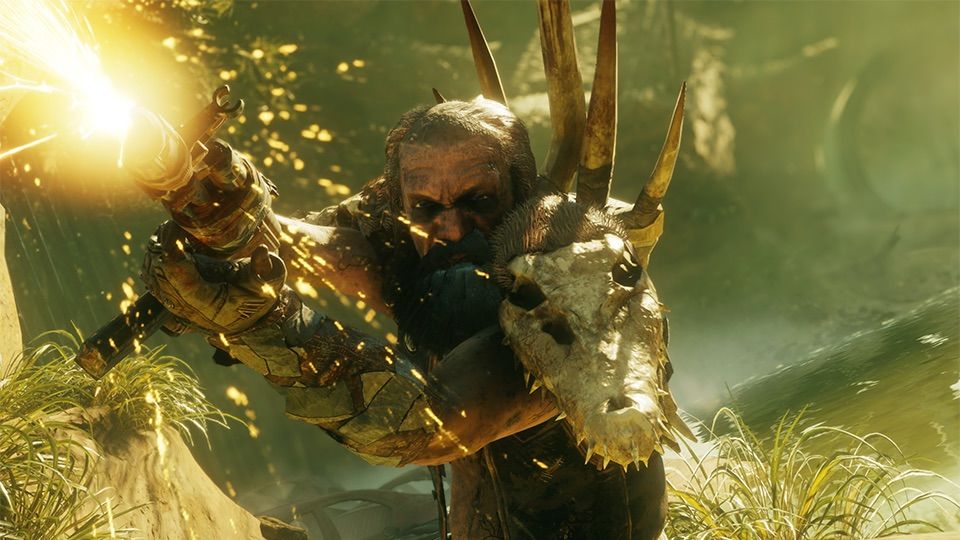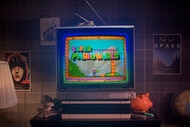Create a free profile to get unlimited access to exclusive videos, sweepstakes, and more!
Rage 2 is all references, much to its demise

The cover art for Rage 2 shows a wild-eyed, androgynous bandit screaming in warrior fury at the viewer. Their hair is a stiff, greasy wedge of Day-Glo blue mohawk, their contorted, scarred face is painted white with the outlines of a skull, and they're dressed in pockmarked football shoulder pads and a loose black fishnet shirt. Their oil-stained hands clutch a double-barreled shotgun. Around this figure, neon pink smears highlight a logo that replaces the title's "A" with an anarchy symbol. The image, in the fashion of so many mainstream video games, is meant to be striking — confrontational and intriguingly violent.
This stands in stark contrast to Rage 2's opening hours, which follow a superpowered post-apocalyptic pseudo-cop named Walker as she survives a bloody attack on her hometown and begins preparing to take down the robotic villain responsible for it. As frenetic and violent as this setup is, it doesn't live up to the vivid image that promotes the game. There is nothing bold, wild, or confrontational about its design. Instead, Rage 2 feels comfortingly familiar.
The sequel to a largely forgotten 2011 first-person shooter by id Software, the studio behind Doom and Quake, Rage 2 is, more than anything else, a years-later rehash of the same concepts that defined its predecessor.
As before, it's a game that substitutes original concepts for a series of references to the games and movies that typify its post-apocalyptic and sci-fi genre trappings, to prevailing design conventions, and to its creators' own recent work. The world that Walker explores is dominated by white-sand deserts and a checklist of activities, such as the twisted hunks of rusted metal barricades and sheds that mark bandit camps filled with homicidal gangs in '70s punk leathers and mohawks. The aesthetic is straight out of the Mad Max films, an effect amplified by Rage 2's roving bands of armed car racers, the high-speed destruction of its automotive combat systems, and the inclusion — expected in post-apocalyptic games now — of a Mad Max Beyond Thunderdome-style gladiatorial arena.
Made by both id Software and Avalanche Studios, whose other work includes the Just Cause series and, notably, 2015's Mad Max action game, Rage 2 tries to complicate its straightforward references to those films with a smattering of futuristic-looking science fiction levels and enormous enemies whose distorted human frames are embedded with high-tech components. Both of these elements, though, are also found in the monsters and environments of id's own 2016 version of Doom and publisher Bethesda Softworks' recent takes on Wolfenstein. The narrative's tone, too, is winking ultraviolence in the pattern of those two games, the player cast as a deadpan, preternaturally skilled soldier with a penchant for destruction surrounded by an oversized cast of characters.
As in the first Rage, the first-person shooting is absolutely fantastic, if now even more familiar. Walker moves at a fighter jet's pace, the game encouraging continuous aggression in shootouts — rather than hiding in cover — through enemies that release bursts of neon blue health pickups when defeated. The shotgun booms like thunder and attackers fly apart in comically grotesque explosions of gore. Each bit of this, while impeccably designed, is modeled after 2016's Doom as well. (Even Walker's metal-gloved hands slap onto elevator buttons and swing out to punch enemies with the same animation style as Doom's space marine, and the soundtrack that pounds behind every shootout features the same fuzzed bass and squealing feedback as Doom.)
There are very few elements that set Rage 2 apart from its inspirations. At its most inventive, Rage 2's setting shifts from Mad Max-ian deserts to fetid jungles in which abandoned suburban homes poke out of the water drowning old streets. The new ideas — a suite of superpowers that allow Walker to do things like launch enemies (and herself) through the air or slam into the ground like a meteor — lend welcome variables to firefights, mixing up the combat just enough to feel different than Doom or the original Rage. But these are small pieces of the whole that do very little to counter the sense that everything in the game has been done before elsewhere.
An obvious mix of references doesn't have to feel unoriginal. Art usually builds on older art, with many worthwhile works borrowing from existing concepts, styles, and themes to create something new. Even Rage 2's references — to Doom, which itself pulls from '80s metal and military sci-fi, and Mad Max, a blend of spaghetti westerns, biker movies, and pulp crime thrillers — are themselves references, though, and the result is that nothing about it feels particularly unique.
This isn't unusual in mainstream video games. So many of the most popular games are riffs on well-established ideas from both other media and whatever design trends have found success in recent years. It gets tiring to counter the enjoyment of even the most exciting shootouts with yet another sandbox world, resource crafting system, or story about a talented gunfighter saving the world that borrows so heavily from what we've played, watched, or read before.
With a more compelling story, game structure, or an audiovisual style that didn't immediately call to mind other media, Rage 2 might have felt as thrilling as its excellent gunfights. By relying on so many other, existing ideas, though, it's predictable and safe. Rather than a bandit yelling at the player's face, Rage 2 gives the impression of watching a favorite movie again or rereading a dog-eared, well-loved novel from childhood — a good enough diversion, but one that comes with the sense that it might be a better use of time to try out something new.


























